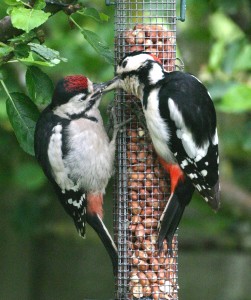 In contrast to the cold weather of the early part of summer, typified by the almost complete lack of butterflies, some birds seem to have had a bumper year. Judging by E-mails from readers this seems to be true in the majority of gardens whether urban or rural. Garden bird feeders have attracted them and one morning on a single feeder I had young juvenile siskins, greenfinches and chaffinches there at the same time. You can tell the ones that have not long left the nest as they are still begging for food from the ever patient adults. All these birds have been coming to feeders filled with peanuts or mixed grain. For some reason most of these birds are still not taking the nyger which is unusual. Only last year nyger seemed to be the favourite food and keeping up with the birds was expensive. Now the favourite food seems to be the sunflower hearts perhaps because they are just the right size for these smaller birds.
In contrast to the cold weather of the early part of summer, typified by the almost complete lack of butterflies, some birds seem to have had a bumper year. Judging by E-mails from readers this seems to be true in the majority of gardens whether urban or rural. Garden bird feeders have attracted them and one morning on a single feeder I had young juvenile siskins, greenfinches and chaffinches there at the same time. You can tell the ones that have not long left the nest as they are still begging for food from the ever patient adults. All these birds have been coming to feeders filled with peanuts or mixed grain. For some reason most of these birds are still not taking the nyger which is unusual. Only last year nyger seemed to be the favourite food and keeping up with the birds was expensive. Now the favourite food seems to be the sunflower hearts perhaps because they are just the right size for these smaller birds.
Interestingly the coal tits and great tits have also been successful and their young are not at the general feeders but showing preference for suet. There is one suet feeder with the suet balls hanging in a vertical feeder whilst the other is a slab of suet inside a small wire cage. At present the cage approach is favourite with the titmice plus starlings and blackbirds. The starlings are dominant and a six by four inch slab of suet goes in a single day. Intriguingly the blue tits seem to be way behind the other titmice as no juveniles have appeared despite the fact that some nestboxes are occupied as I have seen the adults taking food in, mainly caterpillars. There also seems to be five pairs of yellowhammers that have nested either in the garden or close by and these have now brought In their juveniles and all are feeding on the ground on the mixed grain.
Then there is one of my favourite garden birds, the great spotted woodpecker, and by the time this Wildlife In the North is online they, too, will have brought in their juveniles. The normal date for the juveniles to appear, according to my wildlife diary, is more or less the middle of June and they nest in a hole in a tree in the birch woodland above the house. There are two pairs this year and I know because when they leave the feeders they fly off different directions. The male great spotted woodpecker is readily identified by the red patch of feathers on the nape which is absent in the female. Up until a couple of weeks ago it was mainly the males feeding , on both peanuts and suet balls and slabs. They also have a liking for apples and it always seems incongruous to see a great spotted woodpecker pecking away at an apple on the ground with its stiff tail feathers apparently supporting it.
Then a week ago the females started coming in for food and the way they stacked the food in their beaks it was obvious they were taking it back to chicks in the nest hole. Up until then their white plumage on their underparts was so dirty you could easily tell them from the pristine looking males. It was the females job to incubate the eggs and then brood the young and the dirt came from the hole and its contents. When the juvenile appears they can be recognised by the reddish feather over their crown. The photograph I took shows a male feeding a juvenile on peanuts, to show it how it is done.
Tags: highland wildlife
